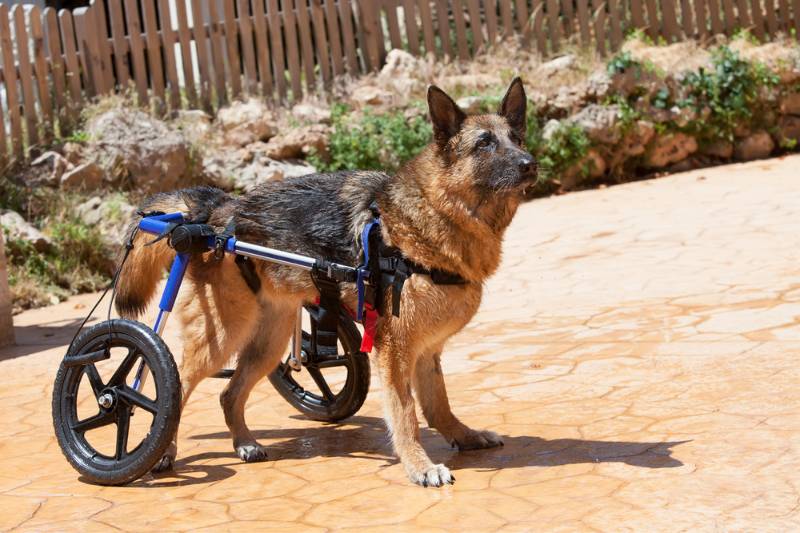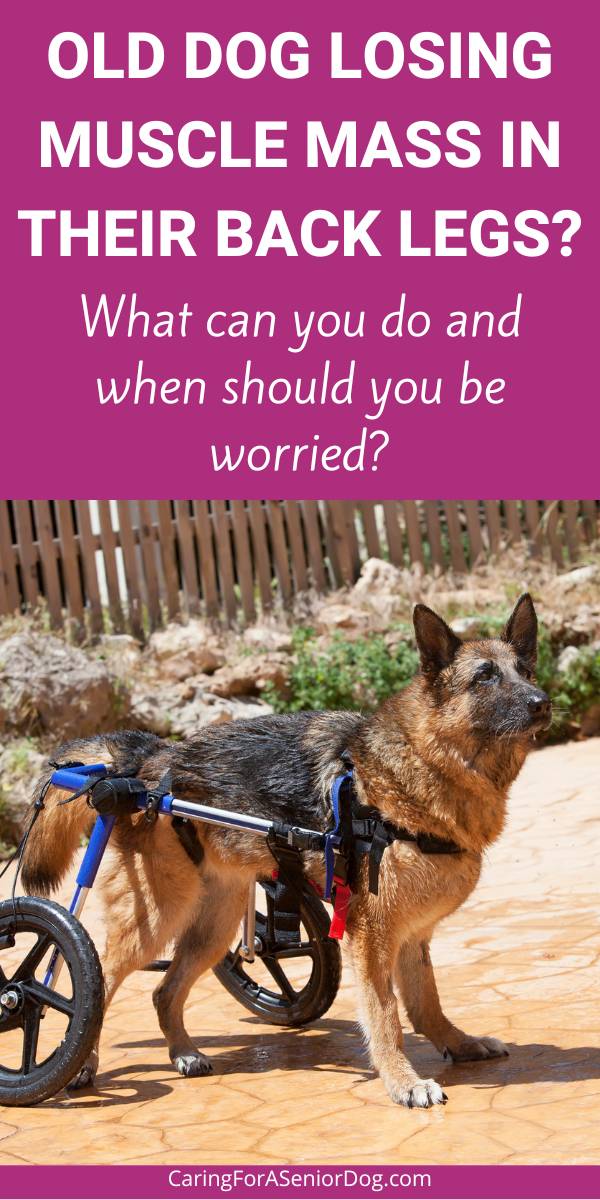As some dogs age, they lose muscle mass in their hind legs. This is called muscle atrophy and can make your dog’s rear legs weak.
You may notice their hind legs slipping out, wobbling when they walk, or your dog falls regularly.
Muscle weakness can develop slowly over time or appear suddenly due to an injury or other condition, such as a genetic disease.
While some age-related muscle loss can be expected, other reasons could be causing your dog’s back legs to slip out, which may require immediate medical attention.
Knowing what to look for and addressing muscle weakness right away is the best way to help.
Disclosure: Some of the links in this article are affiliate links (Amazon Associate or other programs we participate in). As an affiliate, I earn a small commission from qualifying purchases.
Why Is My Old Dog Losing Muscle Mass in Their Hind Legs?
Dogs can lose muscle mass in their hind legs for several reasons, including disease, illness, and injuries.
More specifically, an old dog losing muscle mass in his hind legs is likely due to changes in their body related to age.
Nutritional Needs Change
Older dogs are not always able to process proteins the same way they were able to in their younger years and so may require a nutritional adjustment.
Consult a veterinary nutritionist if your veterinarian believes food could be the culprit for the hind end weakness.
Illness or Disease
Some illnesses or diseases, like arthritis, degenerative myelopathy, and IVDD can cause muscular dystrophy.
IVDD
Intervertebral Disc Disease (IVDD) is a degenerative genetic disease that causes the spinal discs to age faster than normal.
It’s most common in Dachshunds and can also present in other breeds, including Corgis, Beagles, Basset Hounds, Pugs, Pekingese, Chihuahuas, Shih Tzus, Jack Russel Terriers, Mini Poodles, Mini Pinscher, Bichons, and Cocker Spaniels.
Degenerative Myelopathy
Often abbreviated as DM, this genetic disease affects the white matter in the spinal cord, causing it to break down and degenerate, eventually leading to paralysis. It is similar to ALS in humans.
Signs of DM include wobbling, imbalance, swaying in the hind legs, trouble walking, incontinence, and inability to get up.
At-risk breeds include American Eskimos, Bernese Mountain Dogs, Boxers, German Shepherds, Golden Retrievers, Corgis, Rhodesian Ridgebacks, Pugs, and more.
Arthritis
Because dogs are masters at hiding pain, arthritis often goes unnoticed until it’s pretty advanced.
Dogs will display subtle signs like stiffness while walking, reluctance to move, trouble climbing and jumping higher surfaces, and, of course, hind leg weakness.
Any dog breed can have arthritis, though it tends to be more common in larger breeds or overweight dogs.
Lack of Exercise
Dog owners may unknowingly be responsible for the loss of muscle mass if they drastically reduce their old dog’s physical activities.
Too often, senior dog owners assume their dogs are too old to walk, which can cause atrophy due to the lack of use of the muscles.
Signs That Indicate Your Dog Has a Weak Hind End
Depending on the cause of the hind end weakness in your dog, signs may present suddenly or gradually over time.
You may come into a room to find your old dog’s back legs are splayed out or notice they’re collapsing when they try to stand.
Losing muscle mass can show in various ways.
Recognizing the symptoms of muscle atrophy as soon as possible will help you develop a treatment plan with your veterinarian before the problem worsens.
- Rear limb weakness
- Back legs collapsing
- Back legs weak and shaking
- Back legs slipping
- Muscle thinning
- Weight loss
- Limping
- Dragging their rear legs
If you notice any of these symptoms, schedule an appointment with your veterinarian right away to determine the cause of the hind end weakness.
How to Strengthen an Old Dog’s Hind Legs
If the muscle atrophy is caused by inactivity, it is possible to reverse the muscle loss with exercise and proper nutrition.
When disease and illness are the culprits, it may be more difficult or impossible to regain full strength.
It’s important to note that strength-building exercises should be executed only under the guidance of a veterinarian. Doing so without knowing what is wrong could make the problem worse.
Physical therapy can help manage muscle loss and weakness, depending on the issue.
3 Exercises for Weak Back Legs
Dogs don’t naturally pay attention to their hind legs, so practicing hind-end awareness exercises is a great way to build strength if your dog is losing muscle mass.
Regular hind leg exercises with your senior dog should help slow the progression of muscle weakness.
The exercises below are easy ways to build strength in the hind legs at home.
Cavaletti Rails
Commonly used with horses, Cavaletti rails are low hurdles that improve stride length and build rear-end awareness.
The goal is for your dog to step over each pole with each leg. You can use a food lure to guide them over the poles slowly.
This video demonstrates how to use a Cavaletti rail with your dog.
Backing Up to a Target
Place a large, non-slip target on the floor a few feet behind your dog, like a yoga mat, and using body pressure, back your dog up slowly to the mat.
Reward them when they have all four paws on the mat.
Watch this video for more details.
Pivoting
Take a short elevated surface, such as a step stool or balance cushion, and lure your dog’s front paws on top.
Using a food lure and body pressure, have your dog pivot around the stool using only their hind legs. Switch directions.
Other Ways to Help Your Old Dog With Weak Back Legs
In addition to hind-end awareness exercises, there are several other therapeutic remedies that can help your old dog with weak back legs.
Massage Therapy
Massage is a great way to get blood flowing, increase range of motion, and relieve pain in animals. There are pet massage therapists, or you can ask your vet for a few techniques you can perform at home.
Cold Laser Therapy
This non-invasive procedure uses visible and near infrared light to stimulate cell regeneration and increase blood circulation.
Cold laser therapy has been gaining more steam for use on animals in recent years and can be helpful for dogs suffering from arthritis, IVDD, and other ailments.
Hydrotherapy
Hydrotherapy is excellent for dogs with weak hind legs.
The buoyancy of the water takes the pressure off the joints, and the resistance builds muscle. You can search for canine hydrotherapy locations near you.
Acupuncture
Acupuncture can help stimulate the release of anti-inflammatory hormones by using tiny needles placed at pressure points throughout the body.
Treatments last between 30-45 min, and most dogs will fall asleep.
Further, there are a few simple ways to help make your home more comfortable for your dog with weak hind legs include:
- Adding rugs to slippery floors
- Using ramps for the bed or car
- Getting your dog a wheelchair
- Elevating their food and water dishes
- Keeping water in various locations throughout the home
- Using a support sling to help assist them over steps
- Buy your dog non-slip socks or toe grips
Conclusion: Old Dog Losing Muscle Mass in Their Hind Legs
Left untreated, the muscle weakness in your old dog’s hind legs can worsen and lead to other debilitating conditions like paralysis, especially if IVDD and DM are the causes.
You may brush it off, thinking that muscle loss is normal for old dogs, and while it certainly can be, it’s best to get a diagnosis from your veterinarian as soon as you notice weakness in your dog’s rear legs.



 7 Signs That Your Dog Is Getting Old
7 Signs That Your Dog Is Getting Old
Leave a Reply